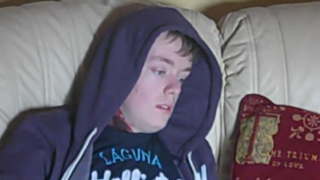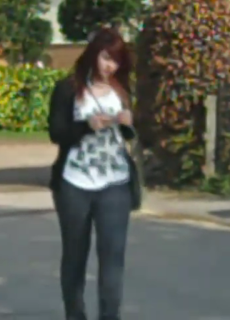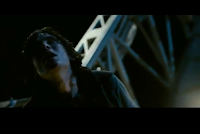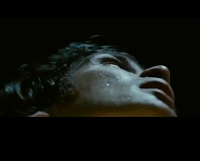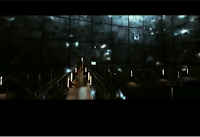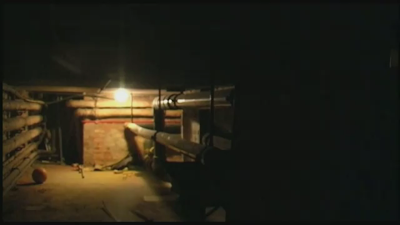Sunday 10 April 2011
Tuesday 5 April 2011
Feedback
We showed our final thriller to a range of people to gain their thoughts and views about what they enjoyed and what we could improve for future projects;
'The use of dark lighting and flashes
worked really well creating suspense
and keeping the audience engaged,
on the edge of their seat.'
'The flashes that occur at the scene change
are very impressive and I enjoyed them,
however the introduction of FirstTakeStudios
should have been more subtle'
'I found it very enthralling and eye-grabbing,
my attention was kept on the screen
the entire time, though the speech
in the beginning should be louder'
'Wonderful! had me on the edge of my seat!!
If im going to be picky when i first saw it i heard
the music effect at the start but then didn't hear
the girl speaking but looking back
maybe the music effect at the start is meant to
be louder to give an impacting effect on the
audience then when the dialogue starts
the sound levels would be right.'
'Very entertaining, thouroughly enjoyed it,
though the phone call could have sounded
more dramatic.'
I was very pleased with the feeback we recieved for our final piece, it made me feel more confident about the final piece.
Evaluation
Evaluation
Even though we cut out the first part of our story and added to our storyline, were very happy with the way our final piece turned out and much happier that we changed and modified our piece.
In what ways does your media product use, develop or challenge forms and conventions of real media products?
By watching several types of different types thrillers, this allowed us to research and look more deeply into the kind of different thrillers that are available, this began to gave us more creative thought about what our own thriller could be about. Also, it allowed us to make more research about the forms and conventions of a thriller film in order to make ours successful.
To begin with we wanted our audience to see a normal situation before adding drama to this, so they could fully understand what was happening in the scene and how it happened instead of starting with the drama.
We showed a normal situation by our lead walking down the street, listening to her music then entering her house and grabbing a drink, already here, we introduce the stain of the hand print, this would have originally created the tension-build but since this was cut from the final piece, the tension began elsewhere.
We used fairly little music in the start of the scene; we didn’t feel any soundtrack was extremely necessary to the scene until we introduced the brother’s neck injury. This is also the scene which highlights the injury and therefore introduces the sinister part of the story.
Our storyline manages to use a mix of a Conspiracy Thriller type and a Mysterious Thriller type, mysterious because the audience is at a loss at why the brother is murdered and why the lead has initially been kidnapped, this does not reveal itself at the end of the opening either. This could also be considered a Conspiracy Thriller because the lead has to overcome an enemy, the person who attacked her though this one is more of what would be to come in the rest of the media piece.
Music begins to pick up when the brother’s injury is revealed, adding to the tension and creating a more atmospheric feeling to our audience. The voice-overs and screams we use also become echoed to add and make it more frightening and distant from the audience.
The editing becomes essential as it introduces a completely new scene with a different location, this introduced by the flashing of the new scene, with a new texture, and the new scene is also introduced by fading in.
How does your media product represent particular social groups?
Our media project represents a normal, average teenager going about her day as normal until she gets home, discovers her brother has been killed and then she is then attacked and kidnapped.
However, when she is attacked, it is unclear how old her kidnapper is and what exactly his motives are, they could be for pure violence or infatuation or something more psychological then this.
Though it is not incredibly frequent, this could be a representation of teenagers that have been murdered and attacked.
What kind of media institution might distribute your media product and why?
Any film company may choose to distribute our film, a large company or a small, independent company might choose to distribute it as it does not appear dependent on effects but does not lack them either, attempting to make it as realistic as possible.
The thriller genre and aspects gives this product a 15 rating, this would mean the product would only be advertised after a certain time on television, though this may affect advertisement and who it would reach to, it should attract a more older generation then a younger one as they are more likely to watch television in the late evening.
As this product is a British, Independent film it may not target a large Hollywood company, more likely target Film Four which is known to be favourable to British films and some low budget films, however using Film Four would not make this move mainstream and only available to a certain percentage of an audience but some Independent Cinemas may choose to distribute this movie also as some are more preferable to amateur talents.
Small TV networks may also be more favourable into showing this product as a straight-to-tv film which would gain plenty of recognition and viewers, though numbers may depend on whether the film was shown on cable or not.
Who would be the audience for your media product?
As the product deals with violence and some tense situations it would gain a 15 rating meaning that the film then attracts an audience of over fifteen years old as they are legally allowed to view this product.
However any age or gender may be attracted to this product, as it does not exaggerate the amount of graphical violence.
How did you attract/address your audience?
We introduced who we were at the start of the video and then introduced the chosen title of the piece, we hoped this would give the audience more of an official and professional feel to our final product, after this we delved straight into our story, introducing our main character and her brothers injury.
We would choose to promote our film on all the main TV channels such as BBC1, BBC2, ITV1, Channel 4 and Channel 5 as these are the most common channels that any television viewer has access too, we chose this so we could have maximum viewing potential. However, this would have to be after a certain time to avoid any chance of causing stress to young viewers.
I think the change in the location helps keep the interest with audience as this makes it appear more mysterious as they do not understand where the character is or why she is there, just like the character herself.
What have you learnt about technologies from the process of constructing this product?
I originally had limited knowledge about using a MAC software and using the imovie editing software that I would then use to edit my final piece. I learnt a great deal about this software by using this to edit my media, which may become useful in the future.
I learnt that having and filming more footage then originally needing is a useful thing as some editing may not turn out as one had hoped, more footage may be needed then originally thought. Some clips may turn out to be inconsistent also, for example if one shot had a door closed, another had the door open. This would result in the need for re-shoots.
I have also learn how to cut a clip to the length I need for the media, how to add a clip to the software which would then become the product, how to add transitions such as fade ins/outs to change the scene and make it more effective, to add music to make the scene more mysterious and tense and lastly how to add lighting in case the filming is in a setting to dark.
Looking back at your preliminary task, what do you feel you have learnt in the progression from it to the full product?
Our continuity was based on using different kinds of camera shots, by coming up with ideas with my group we were able to think up an idea that could be similar to our continuity, it would have the same kind of genre and the same mysterious idea where the character themselves does not know where they are just like the audience.
By first filming and editing the continuity, I was able to learn different ways to film with the camera and then editing the piece on the software, which became useful when it was time to edit my final piece.
By doing the preliminary task it helped prepare me and my group just how long it can take to prepare an idea and then initially film it, preparing for re-shoots. Filming it from different angles and then ultimately editing it, which can be a timely process.
It also prepared us for future issues that could have occurred such as lighting issues, since we came across these in our continuity we were much more knowledgeable how to prevent this in our final piece.
Adding a Voice Over
Adding a Voice Over
Originally in our thriller we had decided to rely on an opening song which would engage the audience with our lead more as it would signify what she was listening to through her headphones.
Since we then decided to cut the beginning of our original piece, we considered adding a voice over at the end of the final thriller as it was only supposed to be an opening and would create another storyline that could possibly continue on the story.
It would also show that several others are also looking for our lead, we first created the idea of her mother but instead changed it to her sister because of the age of our voices, since we wanted it to be more convincing. We introduced the voice-over to make it more convincing that someone was looking for our lead.
Since our new character was going to be talking to the police, we wanted it to sound as official as possible, by watching several scenes of this from TV shows we were able to come up with a similar script that we could use as a voice over for our final piece.
This is the script we used;
Police; This is Emergency…
Sister; Police
Police; What’s your emergency?
Sister; I found a…my brothers body… he’s been killed…please help me!
Police; Address please
Sister; Give Address
Police; Police are on their way…Were you there when this happened?
Sister; No I came home and found him here…
Police; Can you tell me where you found the body?
Sister; On the sofa…I didn’t realise…his throat is slit…my sisters missing…she should be home! Her phones off…what if she’s…please come, she could be missing!
Police; Where do you think she could be?
Sister; She should be at home! The doors open, Jacks dead…
Police; Stay on the line until the police get there please.
Sister; Hurry… We tried to make our script and voice over as authentic as possible as though this was a conversation really going on, to try and ensure it was as real as possible, we recorded it straight of the phone and had the two speakers in different rooms to prevent an echo.
We then needed to edit the voice over, without the laughter and long pauses to make it sound more serious and realistic.
Original Thriller
This was our first attempt at our thriller, the main idea behind this was for our lead to come home and behave like she had not discovered anything unusual, she therefore goes into the living room and just when she discovers that her brother has been brutally murdered, she is attacked from behind.
After watching our piece several times we decided there needed to be more to the story then we had originally planned, we considered cutting out the beginning part of the film of our lead actually entering the house and considered starting the piece of with our lead discovering the body then.
We continued to think of ways to follow on the story, instead of continuing to show our lead being kidnapped we wondered if we should show more footage instead of our lead waking up after being kidnapped, we decided that this could create a more mysterious and chilling atmosphere then more of kidnapping.
We felt that we had managed to cover many of the different types of camera movements, angles and shots but felt that we could challenge ourselves with more in the final piece.
Behind The Scenes
BEHIND THE SCENES
We filmed some footage of us filming our final piece, this included setting up the tripod, different angles we wanted film from, problems that arised and overcoming this problems. There is also some footage shot for when we decided to add in an extra location.
FILMING, DAY ONE and TWO;
Make Up
Make Up
The make up of the lead character was supposed to represent her everyday, usual make up. There was no need for blood on the lead for the first half of the media project.
Some make up we needed was to show blood on the hand of the killer, we revealed the killer to look at the lead from inside the house to make it more creepy, after some thought and discussion we decided that red pain mixed with several others would be the best way to achieve our ‘fake’ blood without looking to ridiculous.
Make Up was also needed on the leads brothers neck, this was to indicate that he had been killed by a knife going into the neck, this was also revealed before the lead discovers it herself so it was essential for it to be obvious to the viewer but not to the lead until it was necessary.
Wardrobe
Wardrobe
There was no specific need for what the wardrobe needed to be for our main lead, it was just supposed to be normal and casual everyday clothes.
We wanted to make it appear like nothing out of the ordinary had happened in their day, it was an average; everyday type and so would wear ordinary clothes. Props/Mise En Scene
Props
We used a small variety of different props in our media project. This included a mobile phone, this became an important part of the film as it distracted our lead character from the idea that her brother had been killed, had she picked up on it earlier there may have been no need to be attacked herself.
The television was also there to distract the character and engage the dead brother into a conversation so the lead would begin to think something was up when he did not respond.
We used duct tape to wrap around our leads hands and tie them together to make it appear as though she had been kidnapped and measures had been taken to ensure she wouldn’t escape.
Mise en Scene
The mise en scene for both scenes were relatively perfect and very few things needed to be changed.
The main issue for both locations was lighting, in the first location; House. This was easily sorted as we decided what lights to be left on and what lights to turn off, the light coming of the television also created a much better effect then any other previous light we had chosen. It created a more peculiar and ghostly feel to the moment.
The lighting in our second location; Under the Swimming Pool, the lighting for this scene, the majority of the time was perfect, however there was one part of the scene where the lighting became an issue and we had to figure out how to dim it. This became difficult as there was no light switch for this particular light.
Storyboards
To help with our planning four our storyline and how we would film it, we drew up several storyboards to plan with. In each box we drew something that would look similar to how we would film it, we would also describe how this was going to happen beneath the picture. This would help remind us or in case the picture was unclear, give us more information as to what was going to be filmed.
We also made notes on what kind of shots we would use in a particular scene, also what type of angle we would try to film it from so we could get the best for the audience.
Some of these notes for the storyboards were for the original thriller we filmed which has since then been cut however this shows our early stages of planning and shows how we have changed and adapted our final piece.
We also drew up some storyboards for the scene we decided to add to the end of our project, this included the under the pool scene with the kidnapped character.
We also made a brief list of props we would need for the shooting so when the day came to film we would all be prepared.
'Sunshine' Scene Analysis
'Sunshine' Scene Analysis
Sunshine directed by Danny Boyle and filmed in 2007 is a scientific and psychological thriller about eight astronauts in space with a mission to make the sun last longer.
During the final scene of the movie, Capa has hoped that their mission has worked and the payload will explode near to the sun to make it brighter again. There is loud music played at the start of the scene. The loud music shows how important and chaotic everything is for Capa in this scene.
He needs it to work, we also hear this from his loud breathing. Close Up Shots are done of Capa as they show us the urgency on his face and the desperation he has in order to make the mission work.
There are also several Extreme Close Up Shots, this is another way to portray the need and desperation Capa feels in this particular moment. One shot is of Capa reaching out and touching the ‘sun’ with his hand, the close up is of his hand as if the audience was the sun itself, this involves them more.
To gain a wider shot, to fully view everything that is happening in this scene, several Mid Shots and Master Shots are taken.
Particularly when the ‘sun’ is coming closer towards him, this is for the viewers to be able to view fully what is happening around Capa and what he is so desperate for.
An Over the Shoulder Shot is also shown to show the audience exactly what Capa sees as it happens in front of him, the audience gets the feel from directly behind him.
The music changes halfway through the scene, it stops abruptly and then starts up again this time with a much slower and softer tone, all that is along with this music is Capa’s heavy breathing which shows once again to the audience his earlier desperation for his mission to work.
High Angles are used to show Capa looking up, this makes the audience feel as though they are looking down on Capa. This also shows how powerless Capa feels in this scene.
Lighting is kept very bright throughout this scene as the story is inching closer to the sun, this is a huge contrast since a lot of the film has darker lighting throughout, the ending scene signifying for the end.
Types of Thrillers
Types of Thrillers
Research into the Thriller Genre
The thriller genre is a large, diverse genre; there are lots of different types of thrillers that can be filmed and have a wide range of interest for all audiences.
These are some of them;
Conspiracy Thriller; A conspiracy thriller is where the hero/heroine has to face a large group of enemies that are powerful and only they recognize their true evils.
Crime Thriller; This type of thriller offers up a suspenseful explanation of previous crimes that may have been successful or failed. These films often focus on the criminal rather then the legal character.
Disaster Thriller; This type of thriller the main conflict is some kind of natural or false disaster
Erotic Thriller; This type of thriller includes erotica and thriller.
Legal Thriller; This is where the hero/heroine with a job such as a lawyer has to confront enemies outside and within inside work that may cause danger towards them.
Medical Thriller; The hero/heroine are workers in medicine working to solve a medical problem.
Mystery Thriller; A type of thriller filled with suspense where the main storyline is the character trying to solve a mystery.
Political Thriller; This type of thriller is where the hero/heroine must ensure the stability of the government.
Psychological Thriller; The conflict between the characters are mental and emotional instead of physical.
Religious Thriller; The plot of these films are closely related to a religious meaning or object.
Supernatural Thriller; This type of thriller brings in a more paranormal and mysterious storyline, adding to the story with tension and suspense.
Techno Thriller; This type of thriller which works with technology which plays an important part of the film.
The Forms and Conventions of the Thriller Genre
The Forms and Conventions of the Thriller Genre
Before we were to begin planning our final thriller scene we watched and studied several thriller films closely and watched out to see if there were any similarities between them and what would help to make the ‘perfect’ thriller.
Some films/openings we watched included; Psycho (1960), Se7en (1995), Taking Lives (2004), Saw (2004)
By watching these films/openings of films closely we were able to study what forms and conventions were included in the thriller genre;
- There are usually several small twists and turns throughout the movie and one final big one that concludes at the end of the film.
- There is usually a lot of violence and action throughout these films, it keeps the audience interested and emphasise the story and makes the film generally more exciting.
- There is usually a more of a psychological depth in these films then some other genres. This allows the audience to understand more of the motives a character has rather then become an average slasher film.
- Cliffhangers are often used to create an on-edge and tense feeling of the movie.
- There is usually a hero/heroine that the audience is able to associate themselves or feel sympathy for.
- Music helps keep the film fast paced or create a slower-tension filled moment.
- Lighting is often used to add help define the mood of a certain scene or character which affects the following story.
Choosing a Location
We needed to decide on where we wanted to film our thriller and what location we wanted. We knew the first part of our thriller opening would take place in an average, normal setting such as a house.
We decided on using one of our own houses and decided on this one.
Originally we had a large percentage of footage from outside the house, so it was essential what the building looked like from the inside, however this footage then got cut for the final scene and therefore was not used.
We decided on using one of our own houses and decided on this one.
Originally we had a large percentage of footage from outside the house, so it was essential what the building looked like from the inside, however this footage then got cut for the final scene and therefore was not used.
Some photos of the rooms we filmed in.
We also added another location to our final scene which was a room under our school's swimming pool, we felt the location had a chilling atmosphere and would be perfect for where our character was going to be trapped in.
Thriller
We made a mind map of what our views and thoughts were about what was essential for the thriller genre.
How is Authenticity Constructed In Episode 1 of ‘Life On Mars’?
How is Authenticity Constructed In Episode 1 of ‘Life On Mars’?
Life on Mars is a fairly recent TV show about a male character, Sam Tyler, who ends up in a coma but goes back to 1973.
This show is set more then 30 years in the past, so lots of things and details have changes since then, including ethical changes, technological and cultural differences. It is a certain eye-opener for viewers to see just how much the changes have been set in place and how different today’s society is to the past.
Technological wise, in the show in 1973, it is made clear that no other character, other then Sam, knows what a mobile phone is, since it does not exist during this time whilst the idea of not owning a mobile phone in modern society is bizarre. There are also no computers, so desks in the workplace are visibly seen, stacked with paperwork in the show.
Police Equipment and Medical Testing has also changed since 1973. The majority of the police equipenrt is different, regarding more guns are used in today’s society then sticks. In the show, it shows that Sam is getting irritated by the idea that no one has checked for fingerprints or run DNA testing on the body found, because this is medical research that is not known in this particular time.
Things are ethically different, in some ways that people are treated and others, the way they are spoken to by other characters. There is unprofessional banter in the workplace and lots of sexual innuendos that perhaps would not be considered appropriate in today’s society for the workplace.
Women are also treated badly and in a way that would not be deemed acceptable in the present day. They are referred to as ‘Skirt’ and ‘Bird’ throughout the episode.
Police are also able to be abusive, physically and violent towards the criminal which is not tolerable in today’s standards.
The police also refer to the criminal getting caught, as ‘Done in’ which is not politically correct by today’s standards. There is also only one black character throughout the entire episode, which shows how more culturally diverse society is now then it was back in 1973.
It is culturally different regarding difference in clothing, old adverts are shown in the episode to show consistency with the past and the way media was produced. In the 70’s it was also legal to smoke in the workplace whereas it is illegal now and anyone caught could be fined.
The value of money has also changed since the 70’s and some drinks have yet to be invented such ‘Diet Coke’ Sam is looked at bizarrely as the characters have never heard of this drink.
This is not the only time this takes place during the episode, Sam is also reacted to bizarrely when he sees a music shop that sells music on Vinyl as tapes and CDs have yet to be invented.
'Se7en' Scene Analysis
'Se7en' Scene Analysis
David Finchers ‘Se7ven’ (1995) includes one very cleverly crafted scene, which involves Morgan Freeman’s character ‘Detective Lt. William Somerset’ opening a box and discovering what is inside.
This scene takes about 40 seconds to reveal itself, which is a generally long scene to unravel a box, but Fincher manages to prolong the wait making the scene filled with tension.
We see several Close Up Shots of the box, firstly when we see the box, the box fills the screen and is the main object telling the audience that what is inside is essential to the next part of the storyline.
The scene then continues to have a close up of William Somerset’s fingers slowly opening the box. We don’t clearly see his facial expression of opening the box until he has fully opened it up.
As he is instructed to open the box slowly and carefully, this creates an eerie and gripping atmosphere to the scene and for the audience as it becomes closer to its revelation.
The next shot is at an Eye Level Angle and whilst we know that William Somerset jumps away from the box, we hear him yelp and know that whatever he has seen has caused him some form of distress. However, we never see this, as the angle is continuously focused on the box, still not revealing to the audience what has actually been seen in the box.
The next scene is a Low Angle of William Somerset’s face; we know from his facial expression that nothing good lies in the box, which remains a mystery throughout the scene.
It is never graphically revealed to the audience what is in the box, we only know through speech from the murderer that it is in fact David Mills wife, however Fincher chose to not show this revelation in a graphic way as it still maintains a disturbing and spine-chilling tone to the scene, as we know that the audience is imagining the state of David Mills wife.
'Psycho' Scene Analysis
Psycho Scene Analysis
Alfred Hitchcocks thriller ‘Psycho’ (1960) is one of the most well-respected and iconic thriller films to date. Its one of the biggest hits, well known for shockingly killing of its female lead in the first act of the film.
The shower scene is the most iconic scene of the entire film because of the sense of tension and danger it creates it just one single scene.
The scene is of Marion Crane being suddenly killed in the shower, the scene is not overly gory and the audience does not see the full act of violence. This makes the scene more fearful and suspenseful for the audience as they begin to imagine what the scene is not showing them.
The illusion of the pain that is being inflicted on Marion Crane is then created in even more depth by the continuous action and ‘stabbing’ motions of the knife, the added sound of the loud music adds a more anxious and on edge feeling towards the audience. The sound is important to this scene, as it does not rely heavily on the graphicness of the blood. The sound of the shower is also used to remind the audience of the normality the scene had been before murder occurred.
Different kinds of camera shots are also used throughout this piece, the use of the Close Up Shot of just Marion’s face helps show the inflicted pain and terrifying incident that is about to take place.
There is also a use of an Extreme Close Up Shot that us used directly on Marion’s mouth, this shows the audience just how generally scared she is and Hitchcock adds to this scene with a piercing scream to make it more effective.
The use of shadows is used, particularly with the killer as the entire face is blacked out so the audience has no idea who the killer could be, this makes this scene eerily scary and also mysterious as this means the motion for the murder is not clear as the killer is not clear.
One editing shot that is used in this scene is the use of the Graphic Match Shot. Towards the end of the scene when Marion has fallen to the bathroom floor, the camera movement follows the shower water draining off, the camera zooms closer of the plug-hole, we see the water go round the plug-hole, this scene then slowly blends into Marion’s eye, making the ending shot a perfect chilling experience.
The use of all these different kinds of camera movements, shots and editing makes the film that more unique which is what Hitchcock set out to create.
Editing
Editing
Editing is essential to a piece of media work as it maintains continuous narrative action, continuity editing then relies on the camera angles, position and direction of each shot to shot. There are lots of different ways to edit a scene.
Cutting
Cutting is used to change the shot or viewpoint and location or scene. There is always a need and reason for a cut as it helps continue the scene, some transitions which are not so abrupt include a dissolve or a wipe.
Shot/Reverse Shot
A shot/reverse shot is where multiple shots have been edited together to show different characters in the scene together, this is often used during a conversation scene.
Eyeline Match
An eyeline match shot is where the fist shot is the characters eyeline and portrays that they are looking in one direction, the second shot shows what the character was looking at.
Graphic Match
Is two shots that are similar to one another and as they blend into one another, they result in a scene change, for example a washing machine going round dissolves into a spinning wheel of a car.
Cross Cutting/Parallel Editing
This is where it shows alternate shots of the same type action happening in a different setting, this is usually simultaneously, these actions are likely to be linking associating the two characters with one another.
Dissolve
This is a transition which changes one scene to another, one scene gradually disappears as another one appears.
Fade In/Fade Out
This involves one scene gradually getting darker as it fades out to end the scene, or to start the scene it becomes lighter to show the scene fading in.
Long Take
A shot that continues for an unusually long amount of time before it transitions for another shot.
Short Take
A shot that happends very quickly, mostly for a reaction shot.
Slow Motion
An action that takes place in a much slower rate then what it usually would happen, this is a slower rate then what it would have been originally filmed by the camera.
Subscribe to:
Posts (Atom)


